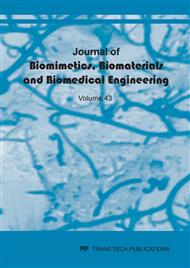[1]
Clowes G.H.A., Jr., Bypass of the heart and lungs with an extracorporeal circulation. In: Gibbon JH, Sabiston DC, Spencer FC, (Eds.) Surgery of the chest. 2nd ed., Saunders, Philadelphia (1969).
Google Scholar
[2]
Utley J.R. Early development of cardiopulmonary bypass. Perfusion. 1(1) (1986) 1-14.
Google Scholar
[3]
Galletti P.M., Brecher G.A. Heart-Lung Bypass. Principles and techniques of extracorporeal circulation, Grune & Stratton, New York, (1962).
Google Scholar
[4]
Rodewald G. History of extracorporeal circulation. In: Hagl S, Klövekorn W.P., Mayr N., Sebening F., (Eds.) Thirty years of extracorporeal circulation, Carl Gerber, Munich, 1984, pp.25-43.
DOI: 10.1177/026765918600100110
Google Scholar
[5]
Hurst, J. W., Fye, W. B., & Zimmer, H.-G., The heart-lung machine was invented twice-the first time by Max von Frey. Clinical Cardiology, 26(9), (2003) 443–445.
DOI: 10.1002/clc.4960260914
Google Scholar
[6]
Gomes O.M.C., Conceição D.S., Circulação extracorpórea. In: UFMAG (Ed.) Histórico. Circulação extracorpórea. 2nd ed., Belo Horizonte, (1985).
Google Scholar
[7]
Litwak R.S., The growth of cardiac surgery: historical notes. Cardiovasc Clin 3(2), (1971) 5-50.
Google Scholar
[8]
Johnson S.L., The history of cardiac surgery,. Johns Hopkins Press, Baltimore, 1970, pp.1896-1955.
Google Scholar
[9]
Passaroni, A. C., Silva, M. A. de M., & Yoshida, W. B., Cardiopulmonary bypass: development of John Gibbon's heart-lung machine. Revista Brasileira de Cirurgia Cardiovascular (2015).
DOI: 10.5935/1678-9741.20150021
Google Scholar
[10]
Konstantinov, I. E., & Alexi-Meskishvili, V. V., Sergei S. Brukhonenko: the development of the first heart-lung machine for total body perfusion. The Annals of Thoracic Surgery, 69(3), (2000) 962–966.
DOI: 10.1016/s0003-4975(00)01091-2
Google Scholar
[11]
Oransky, I., Clarence Dennis. The Lancet, 366(9488), (2005) 802.
DOI: 10.1016/s0140-6736(05)67203-0
Google Scholar
[12]
Dennis, C., Spreng, D. S., Nelson, G. E., Karlson, K. E., Nelson, R. M., Thomas, J. V., … Varco, R. L., Development of A Pump-Oxygenator To Replace The Heart And Lungs; An Apparatus Applicable To Human Patients, And Application To One Case*. Annals of Surgery, 134(4), (1951) 709–721.
DOI: 10.1097/00000658-195113440-00017
Google Scholar
[13]
Newman, M.F., Kirchner, J.L., Phillips-Bute, B., Gaver, V., Grocott, H., Jones, R.H., Mark, D.B., Reves, J.G., Blumenthal, J.A., Longitudinal assessment of neurocognitive function after coronary-artery bypass surgery, New England Journal of Medicine 344 (6) (2001) 395.
DOI: 10.1056/nejm200102083440601
Google Scholar
[14]
Blauth, C.I., Cosgrove, D.M., Webb, B.W., Ratliff, N.B., Boylan, M., Piedmonte, M.R., Lytle, B.W., Loop, F.D., Atheroembolism from the ascending aorta. An emerging problem in cardiac surgery, The Journal of Thoracic and Cardiovascular Surgery 103 (6) (1992) 1104.
DOI: 10.1016/s0022-5223(19)34874-3
Google Scholar
[15]
Likosky, D.S., Marrin, C.A.S., Caplan, L.R., Baribeau, Y.R., Morton, J.R., Weintraub, R.M., Hartman, G.S., Hernandez Jr, F., Braff, S.P., Charlesworth, D.C., Determination of etiologic mechanisms of strokes secondary to coronary artery bypass graft surgery, Stroke 34 (12) (2003) 2830–2834.
DOI: 10.1161/01.str.0000098650.12386.b3
Google Scholar
[16]
Djaiani, G., Fedorko, L., Borger, M., Mikulis, D., Carroll, J., Cheng, D., Karkouti, K., Beattie, S., Karski, J., Mild to moderate atheromatous disease of the thoracic aorta and new ischemic brain lesions after conventional coronary artery bypass graft surgery, Stroke 35 (9) (2004) e356–e358.
DOI: 10.1161/01.str.0000138783.63858.62
Google Scholar
[17]
Avrahami, I., Dilmoney, B., Hirshorn, O., Brand, M., Cohen, O., Shani, L., Nil, R.R., Bolotin, G., Numerical investigation of a novel aortic cannula aimed at reducing cerebral embolism during cardiovascular bypass surgery, Journal of Biomechanics, 46(2) (2013) 354–361.
DOI: 10.1016/j.jbiomech.2012.11.004
Google Scholar
[18]
Weinstein, G.S. Left hemispheric strokes in coronary surgery: implications for end-hole aortic cannulas, Annals of Thoracic Surgery 71 (1) (2001) 128–132.
DOI: 10.1016/s0003-4975(00)02208-6
Google Scholar
[19]
Fukuda, I., Minakawa, M., Fukui, K., Taniguchi, S., Daitoku, K., Suzuki, Y., Hashimoto, H., Breakdown of atheromatous plaque due to shear force from arterial perfusion cannula, Annals of Thoracic Surgery 84(4) (2007) e17–18.
DOI: 10.1016/j.athoracsur.2007.06.013
Google Scholar
[20]
Machin, D., & Allsager, C., Principles of cardiopulmonary bypass, Continuing Education in Anaesthesia Critical Care & Pain, 6(5) (2006) 176–181.
DOI: 10.1093/bjaceaccp/mkl043
Google Scholar
[21]
Swaminathan, M., Grocott, H. P., Mackensen, G. B., Podgoreanu, M. V., Glower, D. D., & Mathew, J. P., The Sandblasting, Effect of Aortic Cannula on Arch Atheroma During Cardiopulmonary Bypass, Anesthesia & Analgesia, 104(6) (2007) 1350–1351.
DOI: 10.1213/01.ane.0000264090.24756.08
Google Scholar
[22]
Hamano, K., Ikeda, Y., Mikamo, A., Okada, H., Gohra, H., Zempo, N., … Esato, K., Atheromatous Plaque in the Distal Aortic Arch Creating the Potential for Cerebral Embolism During Cardiopulmonary Bypass, Japanese Circulation Journal, 65(3) (2001) 161–164.
DOI: 10.1253/jcj.65.161
Google Scholar
[23]
Koh, T. W., Parker, K. H., Kon, M., & Pepper, J. R., Changes in aortic rotational flow during cardiopulmonary bypass studied by transesophageal echocardiography and magnetic resonance velocity imaging: a potential mechanism for atheroembolism during cardiopulmonary bypass, Heart and Vessels, 16(1) (2001) 1–8.
DOI: 10.1007/pl00007273
Google Scholar
[24]
Garcia-Rinaldi, R., Vaughan, G. D., Revuelta, J. M., Goiti, J. J., & Gomez-Durán, C., Simplified Aortic Cannulation, The Annals of Thoracic Surgery, 36(2) (1983) 226–227. [25] Evangelista, A., Flachskampf, F. A., Erbel, R., Antonini-Canterin, F., Vlachopoulos, C., Rocchi, G., … Plonska-Gosciniak, E., Echocardiography in aortic diseases: EAE recommendations for clinical practice, European Journal of Echocardiography, 11(8) (2010) 645–658.
DOI: 10.1093/ejechocard/jeq056
Google Scholar
[26]
Shibeshi, S. S., & Collins, W. E., The Rheology of Blood Flow in a Branched Arterial System. Applied Rheology, 15(6) (2005) 398–405.
DOI: 10.1515/arh-2005-0020
Google Scholar
[27]
Morris, L., Delassus, P., Callanan, A., Walsh, M., Wallis, F., Grace, P., & McGloughlin, T., 3-D Numerical Simulation of Blood Flow Through Models of the Human Aorta. Journal of Biomechanical Engineering, 127(5) (2005) 767.
DOI: 10.1115/1.1992521
Google Scholar


